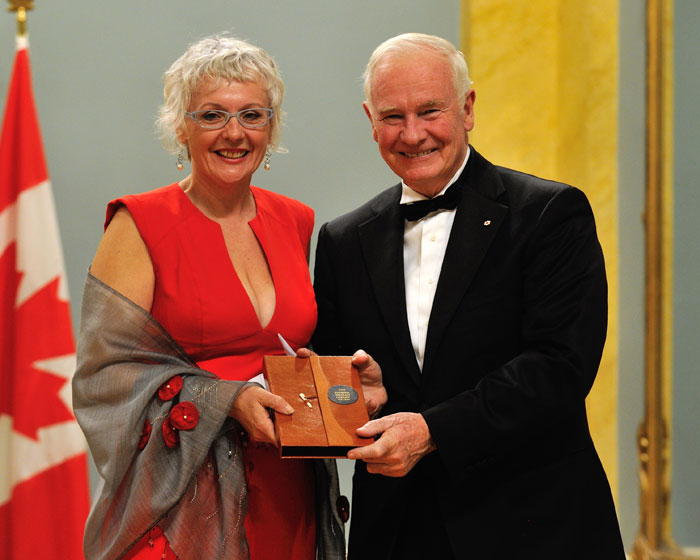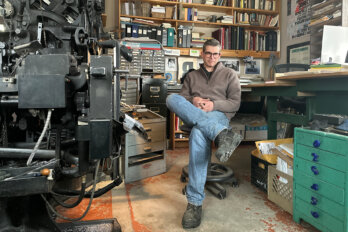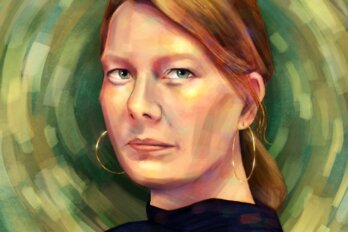
It’s a common enough pattern. When asked about their childhood, medical school students speak warmly about the wonderful pediatrician, the caring family doctor. Young writers cite the complexity of the characters in Austen, the simple elegance of Hemingway, or the adrenaline of Kapuscinski. Teachers talk about their teachers. And so it is with Catherine Banks, who taught before she became a playwright. To be sure, she was influenced by Tremblay and Fornés, but those names aren’t mentioned before the school teacher who never criticized her early poetry, or the instructor of a six-week playwriting course who first asked her to write in dialogue.
Inspired by, and structured around, Wallace Stevens’ poem “Thirteen Ways of Looking at a Blackbird,” It Is Solved by Walking is Banks’ second Governor General’s Literary Award–winning play. (In 2008, she was awarded the prize for Bone Cage). The newer work was praised by the jury for creating “a singular and inspired love story that is also a meditation on the need to give full expression to the complexity of one’s inner life.” Banks is now at work on two projects: Miss ’n Me, a play borne out her love for the music of Missy Elliott, and an adaptation of Ernest Buckler’s The Mountain and the Valley. She grew up in Yarmouth, Nova Scotia and now lives in Sambro, a fishing village outside of Halifax.
When did you first read “Thirteen Ways of Looking at a Blackbird”?
I was probably sixteen or seventeen.
Has your understanding of it changed over the years?
It’s a very beautiful poem. For a long time, I was just at surface level—I read it as a series of images. And, actually, it wasn’t until a few years ago that I read what Stevens wrote about the poem being a collection of sensations. I was amazed by that. It sent me back to the poem, and I started thinking about the sensation resident in each one of its thirteen stanzas. That was the beginning of It Is Solved by Walking.
Where did you go from there?
Very early in the morning, I read the poem and thought “Well, what would be the sensation of this first stanza? ” And for some reason, waking up in the morning, I thought “I wonder if I could relate it to sex? ” It was so playful and so fun to come up with that idea—that sensation—that I just decided that, for the next twelve mornings, I would wake up, read a stanza, and then just write a monologue. Over time, I started working with those monologues and creating scenes.
Can you describe how you create your characters?
They just arrive, fully formed. They are named instantly. I know who they are. And then I just try to write their stories down as clearly as I can.
Some writers talk about eventually hitting a spot where their work takes off, almost on its own. Does that happen to you?
Yes. Once you start to get into a play, then the world seems to deliver solutions. You start to see the world in the terms of your play. That happens late, when you’re struggling to make the last connections that are going to really pull the play together. I’m in that place right now with Miss ’n Me. Everything feels ready, but I need that big moment. It’s being very stubborn.
Is the opposite true as well—that a play can just slip away?
When I was writing Bone Cage, Bitter Rose, this one-person show,came forward. So I wrote that [instead]. Then, for a lot of reasons, I wasn’t getting back to Bone Cage. Whenever I thought about the main character, he was kind of sitting down by the river waiting for me to show up. But one day, when I was thinking about him, he wasn’t there. I went looking for him, and I felt like he was driving away—that he was at a point where he wasn’t going to stick around anymore. The story was disappearing, and if I didn’t start writing it, I never would.
Do you have any writing rituals?
Walking is an important part of the process. I’ll take a notebook with me and some lines will start to come as I walk. I’ve also learned that if I wake up and start writing as soon as I open up my eyes that I get really rich material—particularly when I’m stuck or in those early months creating a new piece.
Are you aware of an audience when you write?
No, my commitment is to the characters and to their story. The reality of theatre today is that you can’t have a lot of characters and you can’t have a big set, but I can’t allow that to enter in when I’m creating—it’s too interfering.
Do your characters talk to you?
When I’m writing the play, I’m only an observer in their world. They don’t talk to me and I don’t talk to them.
And later on, after the play’s finished?
Sometimes. Particularly Jamie [the central character in Bone Cage]. I feel very strongly that he’s present at times. When I couldn’t find anybody to produce that play, I had this thought come to me that I guess I put through Jamie: “You take care of getting me on stage once, and I’ll take care of the rest.” That was the moment when I really committed to self-producing the script.
What does it mean to win a Governor General’s Literary Award?
The first time, it was so affirming. I hadn’t been able to find anybody to produce Bone Cage; a lot of the time, I felt that people didn’t think it was good. Then, when you win, you get asked to do lots of things—sit on juries, attend literary events, speak at things. And so, over time, I’ve just generally become more confident that I’m a writer, which I hadn’t been before. So that was the real, wonderful gift of winning: to begin feeling like a writer. I’m still absorbing this one, but I love the play and I just hope it means, as always, that it gets more productions.
In the introductory notes to It Is Solved by Walking, you wrote, “First and foremost this play is about light.” What did you mean by that?
For me, the play is about Margaret finally coming out of her head and seeing the light. To Wallace Stevens, poetry was the light of the imagination, and so, by the end of the play, I just wanted it to be flooded with light—with that feeling that all the darkness had been defeated. She’s healed herself, and she’s ready to move forward.
This interview has been condensed and edited for publication.




